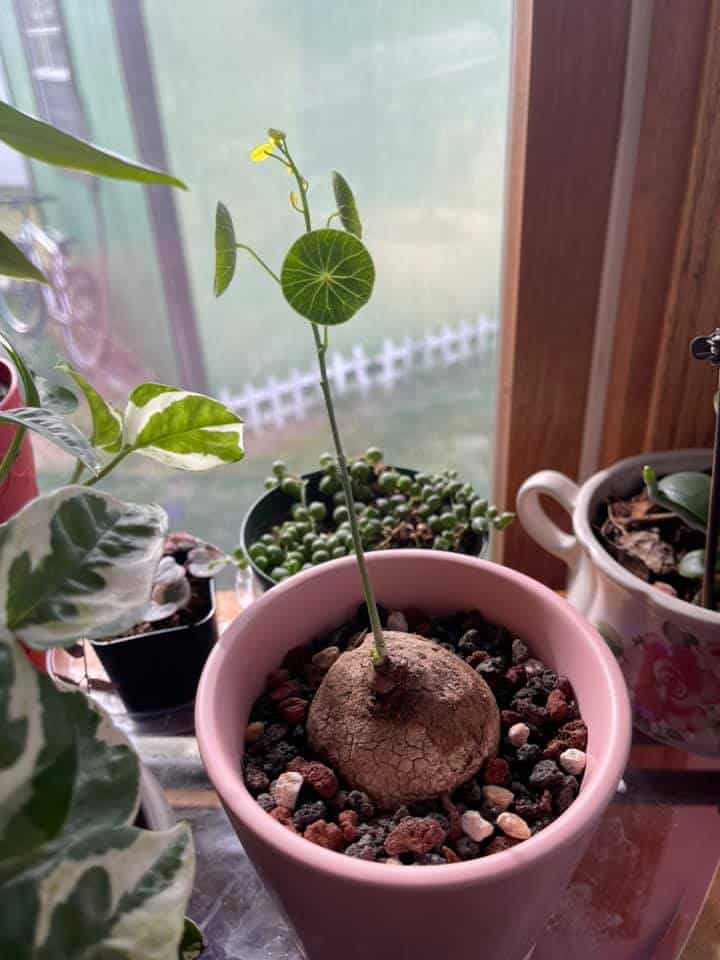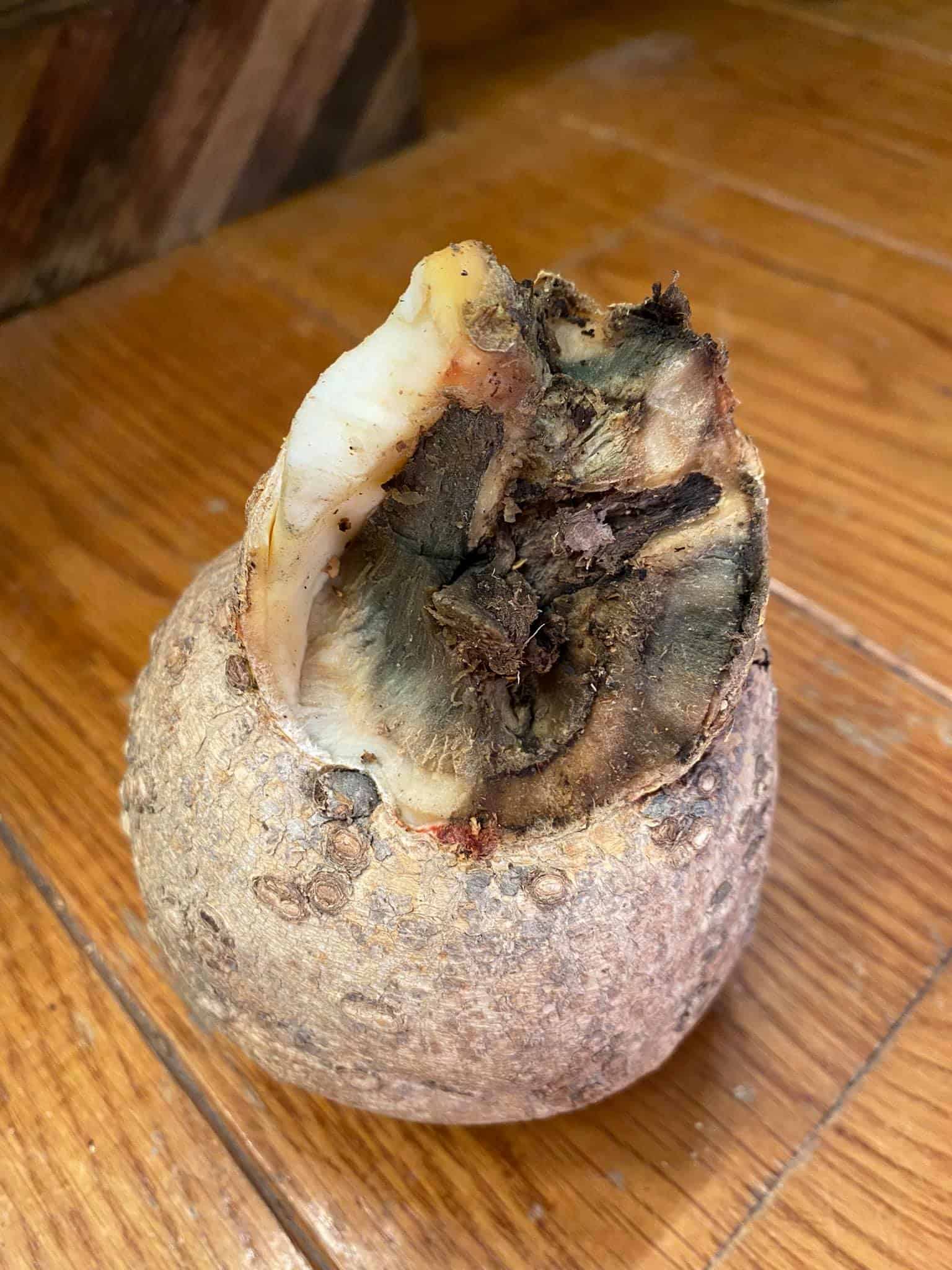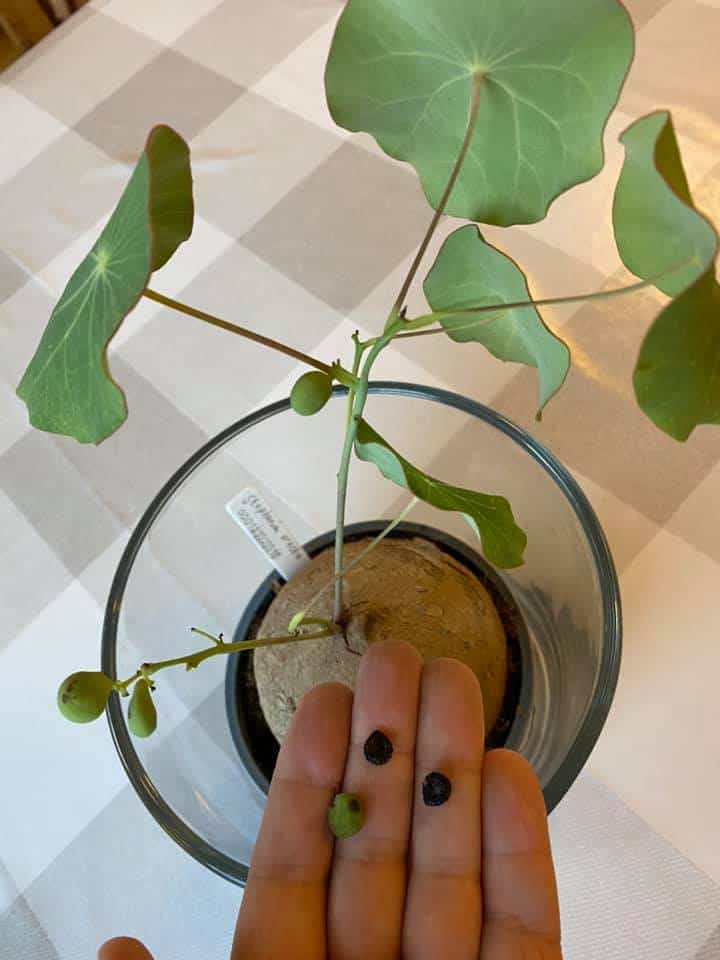Is your Stephania erecta dropping its green, plate-like leaves, and bushy flowers? Less care can give this tropical vine hardship, but a proper watch will grace new leaves and blooms on the plant again.
Even with all the care, Stephania Erecta is unsafe from pests and diseases, but with the following guide, you can provide the plant with a jovial home. Stay tuned!
Table of Contents Show
Stephania Erecta Plant: Overview
Do you know Stephania Erecta is also called a “Potato Plant”? You will not find thick stems on the plant.
This is because the plant produces foliage on a potato-like woody bulb. Botanically, this bulb is a “caudex” that helps to hold in water.

Apart from its potato-like body, the plant holds some of the best-kept secrets in the houseplant world. Let’s learn about them from the table.
| Features | Descriptions |
|---|---|
| Scientific Names | Stephania erecta Stephania pierrei |
| Common Name | Potato Plants Fat-Bottomed Plants |
| Family | Menispermaceae |
| Status and Ecology | Life Cycle: Tropical Deciduous Habit: Climbing or Vining Caudiciform Succulent (Bulbous Stem) Habitat: Tropical Mountainous Forests and Semi-Dry Habitats Native Range: South-East Asia and Some Parts of Australia USDA Zone: 10 |
| Growth Rate | Slow |
| Plant Size | Height: 3 Feet Caudex Diameter: 6-7 Inches |
| Growth Periods | Spring to Summer |
| Leaf | Shape: Circular, Coin-Shaped (Peltate) Size: 2-2.5 Inches (Diameter) Color: Green to Light-Green Texture: Smooth and Leathery with Veins |
| Flowering Season | Early to Late Spring |
| Flower | Inflorescence: Umbelliform Cymes Color: Creamy White to Yellow Shape: Star-Shaped Clustered Flowers |
| Grown for | Attractive Caudex and Plate-like Foliage |
| Toxicity | Toxic to Humans and Pets |
A Complete Care Guide to Stephania Erecta Plant
As a tropical plant with a succulent stem, Stephania Erecta needs slightly different care.
You must replicate a tropical environment indoors while providing the care you would offer a regular succulent.

1. Light and Temperature
Stephania Erecta requires balanced light and temperature care such that the plant can get enough light without showing any effect of surging temperature.
Therefore, due to its succulent habit, Stephania Erecta can do well in a limited amount of direct sunlight. But, direct sunlight for a long can harm its leaves.
Similarly, the plant cannot do well in low light and temperature either. Irregular light and temperature can hurt the leaves and halt their growth.

Excessive Light and Temperature: Gradual wilting, yellowing, and browning leaves with curled and crispy edges.
Low Light and Temperature: Slow growth, limpy leaves with a yellow hue, and progressive leaf drops.
To save the plant, follow a careful set of light and temperature conditions.
Tips to Recover From Light and Temperature Issues
- Place the plant near an east-facing window in spring and summer, or keep it 3-5 feet away from a south-facing window.
- Use drapes or curtains to shield the plant from scorching sunlight.
- Monitor the temperature changes and avoid letting the temperature go below 50°F.
- Avoid placing the plant near a north-facing window in winter, and use frost blankets to protect it from cold drafts.
- You can also use LED grow lights. In cold places, heating mats also can do wonders for your plant to escape cold.
2. Watering and Humidity
Stephania Erecta can forgo watering for long periods, but frequent watering combined with high humidity is deadly.
High humidity is not a problem for this tropical plant, but low surrounding moisture can cease its growth.
Since Stephania Erecta has backup water in its stem, it can resist underwatering conditions.
But, you must maintain a constant watering schedule and avoid frequent watering by maintaining high humidity. If unchecked, the leaves and roots can suffer severely.
Signs of Overwatering: Soggy and yellow leaves, “wet feet,” and root or bulb rot.
Symptoms of Underwatering: Dry, wilting, and yellow to brown leaves with crispy margins.
Effect of Low Humidity: Fewer blooms and leaves with declining leaf size.
However, Stephania is a sturdy plant and can bounce back from watering and humidity issues with proper watering tips.

Tips to Water Stephania Erecta
- In fall and winter, water Stephania Erecta every 3-4 weeks when the top 2-3 inches of soil dries out by giving a finger dip test.
- Avoid leaving any water drops in the plant leaves to prevent the growth of fungal diseases.
- If the soil gives off any fishy or foul smell, unpot the plant and check for root rot. Remove any pulpy roots.
- Mix the soil with organic perlite to improve percolation.
- Mist the leaves during summer to cool the plant or group it with other houseplants to increase the surrounding humidity.
3. Soil and Fertilizer
Since Stephania Erecta has succulent characteristics, the plant prefers soil that drains well with minimum fertilization.
Hard soil can bring out waterlogging issues and affect the root system and leaves.
Similarly, it’s ideal to stop fertilizing the plant completely in fall and winter when the bulb or caudex becomes dormant, as the plant may suffer from root damage.
However, this slow-growing plant normally needs less fertilizer and shows no signs of nutrient deficiency.
Signs of Overfertilization: Progressive yellowing of leaves, browning of leaf margins (fertilizer burn), and root damage.
Symptoms of Underfertilization: Fewer blooms, smaller leaves, stunted growth, changing leaf color, and nutrient deficiencies.
Improper Soil Signs: Waterlogging and stagnant water on the topsoil.
Although Stephania Erecta can bounce back from the soil and fertilizer issues, you must quickly take action once these bad signs are noticeable.
Soil and Fertilizer Tips for Stephania Erecta
- It’s better to offer half-diluted fertilizer in the growing seasons.
- Always fertilize the plant during watering bouts to leach the nutrients deeper into the soil layers.
- Wash the soil 4-5 times with distillate water to flush out the excess salts from the soil.
- Unclog the drainage holes once a week to ensure good drainage.
- Place some pebbles at the pot’s base while repotting the plant.
4. Infrequent Repotting
The caudex or bulb of the Stephania Erecta grows slowly and can stay in the same pot for many years without any trouble. So, the plant requires sparse repotting.
Stephania Erecta doesn’t need much repotting and likes to stay in a small pot but eventually needs repotting when it becomes rootbound.
Symptoms of Root Bounding: Stunted growth, production of fewer foliage, enlarging bulb, quick draining of water, and protrusion of roots from the drainage holes.
Remember, Stephania Erecta doesn’t have an accurate repotting schedule, but you must always check for obvious signs.
Additionally, the caudex of the plant becomes dormant in fall and winter, so you must wake it first by soaking it in a warm water bath for 24 hours.
Tips to Repot Stephania Erecta
- Uproot the plant from the old planter, fill a new pot with a few pebbles, and add the suitable potting mix at the base, not more than 3 centimeters thick.
- Gently untangle the roots and avoid removing all the soil from the bulb’s base to prevent transplant shock.
- Place the bulb at the center of the new pot and then add soil from the sides, filling the pot up to an inch below the brim.
- Cover only 20% of the bulb’s base with soil to encourage gradual root growth.
- Moist the soil and keep the plant in bright indirect sunlight for a few weeks to recover it.
To place the bulb in the soil for the first time, fill a pot with two-thirds of the soil, place the soaked bulb on it, cover the bulb’s base with compost, gently hydrate, and continue with normal routine care!
You can watch the entire process of repotting in the following video.
5. Regular Pruning
There is no perfect schedule for pruning Stephania Erecta, as it sheds leaves every fall and winter.
But, the leaves may become yellow during the foliar cycle, so you must remove the spent foliage to entice the plant to produce more leaves.
The stems or vines of the plant also get leggy and may crawl all over the place. So, it’s better to remove them for bushier growth.
Prune Stephania Erecta every 4 weeks using sterilized scissors to remove the dead or diseased leaves.

Additionally, pests (aphids, mites, thrips, whiteflies, and mealybugs) and diseases (leaf spots, root rots, and mildews) can also affect the leaves and bulbs of the plant.
Moreover, the diseased or pest-infested leaves can pose a problem for the plant if they are not cut and can extend to nearby houseplants.
Tips to Prune Stephania Erecta Plant
- Prune the spent leaves entirely at the end of the petiole using sterilized scissors.
- For pest-infested or diseased foliage, cut the entire vine bearing that leaf.
- Burn all the leaves or vines after trimming to prevent the extent of the diseases.
- For untimely disease or pest outbreaks, use Q-tips dipped in neem oil to dab the bugs or spray on the leaves every 3 days until the plant regains healthy foliage.
Growth Feature of Stephania Erecta Plant
Stephania Erecta is a slow-growing houseplant and takes around 20 years to reach 3 feet of mature height indoors.
But, in fall and winter, the plant drops all its leaves (owing to the deciduous habit), leaving the bulb bare.
As such, the bulb becomes dormant and only forms new growth again in spring from the node at the top of the bulb.

Furthermore, the bulb or caudex is usually 6-7 inches wide. So, a larger pot allows the bulb to grow extensively.
Immediately waking from dormancy, the plant gains enough energy to bloom, usually from early to late spring.
Clusters of creamy white to yellow flowers grow alternately along the length of the stem or vine.
Following the brief pollination phase, the plant enters the fruiting and seeding stage, which ends in late summer.
The fruits of Stephania Erecta are circular to oval pods that contain tiny brown-to-black marginally ridged seeds.
Toxicity of Stephania Erecta Plant
Stephania Erecta is mentioned as a toxic houseplant poisonous to humans and pets, but its toxicity level is unsure.
But, there is hardly any proven claim that describes its toxicity.
Although some species of Stephania are used as a fish poison, this species can pose some threat to some degree.
However, symptoms like vomiting, nausea, and loss of appetite are evident if the leaves or plant parts are ingested in large amounts.
Additionally, plant parts can pose choking hazards to children and pets. So, it’s best to keep the plant away from them.
Moreover, you can employ the deterrent methods like coning the pets or anti-chew sprays.
Stephania Erecta Plant Propagation
The feasible way to propagate Stephania Erecta is via seeds.
You must harvest the seeds in late summer after the flowering season.
- First, soak some seeds in lukewarm water in a warm and dark place for 24 hours.
- Take a seed starter tray and fill it with suitable potting soil.
- Place the seeds about 0.2 inches deep in the soil. Plant only a single seed in one section.
- Cover the seeds with plastic wrap to secure humidity, and locate the set up in dappled sunlight for 4-6 hours daily.

- Place the seed tray on a heating mat maintained at a temperature of 60-80°F.
- Lightly sprinkle distillate water when the potting mix dries. Seeds may take 1-5 months to germinate.
- When the seedlings sprout 2-3 leaves, transplant them individually to a 2-3 inches wider and deeper terracotta pot.
Harvesting & Storing Stephania Erecta Bulb
Once the summer ends, Stephania begins to shade its foliage and becomes dormant.
But Stephania’s bulb will sprout new leaves again in spring.
However, you must secure the bulb in a safe place where it can sleep in winter and grow again later.
- First, water the soil and pry the bulb out by turning the pot upside down by holding the stem.
- Keep the bulb in a mesh bag in a dry and well-ventilated area and avoid bright light.
- When spring comes, you can replant those bulbs in a proper potting mix after giving them a warm bath.
Stephania Erecta Plant for Sale
If you decide to bring this beautiful houseplant into your home, here are a few recommendations for buying.
| Shops | Expected Delivery Date |
|---|---|
| Amazon | Within 4-5 days after placing an order |
| Etsy | Within 1-1.5 months after placing an order |
| Logees | Within 1-2 days after placing an order |
| The Plant Farm | Within 2-10 days after placing an order |
FAQs About Stephania Erecta
Is Stephania Erecta a Succulent?
Stephania Erecta is a caudiciform succulent with a relatively fleshy, bulbous, potato-like stem that holds water.
Which Side of Stephania Erecta Bulb is Up?
To know about the upper and basal side of Stephania Erecta, you must check for a bumpy node. This node represents the top side of the bulb.
Are Yellowing and Leaves Falling of Stephania Erecta Natural?
If it’s winter and the plant is entering dormancy, it is natural for the leaves to go yellow and fall off.
But in the growing season, the leaves can turn yellow and fall off due to less or more nutrients, pest or disease infestation, and moisture issues.
From Editorial Team
Store the Bulb Properly!
The bulb or caudex is crucial for the plant to give it a new life i.e., new stems and leaves. When summer ends, buckle up to save the bulbs in a dry and well-ventilated place, but don’t bruise or water them as they may turn unviable.



4 comments
Similar to some of the pictures above, the leaves of my Stephania Erecta remain light green without the vining design 🙁 Would you have any suggestions why this is?
The most common reason why this happens is that your plant isn’t getting enough sunlight and water, so you should place it in a location where it can get at least 6 hours of daylight every day.
However, if your plant color is Light green, Fertilizers will enrich the greenery of leaves and make them more resistant to diseases. Hence, you can fertilize your plant once every two weeks, but only during the springtime.
H-E-L-P!! My new Stephania bulb sprouted a couple of months ago and has happily grown to a height of 3 feet…and not a leaf in sight! I have it supported, water regularly with a weak solution when watering. She gets lots of indirect sunlight and has other plants around to keep her company! The stem keeps growing but only tiny “buds?” that never take off. Should I cut the stem back and hope it fills out? She is in a small pot hoping that would cause her to bush out! ANY SUGGESTIONS?
Can you tell me how old your plant is? Even if it is 3 feet tall, it can take a long time to get there, even 20 years, for the tuber to reach maturity. So you might have to wait more before getting to see the leaves. Also, make sure you fulfill all the care needs and regularly check the plants to be rootbound.